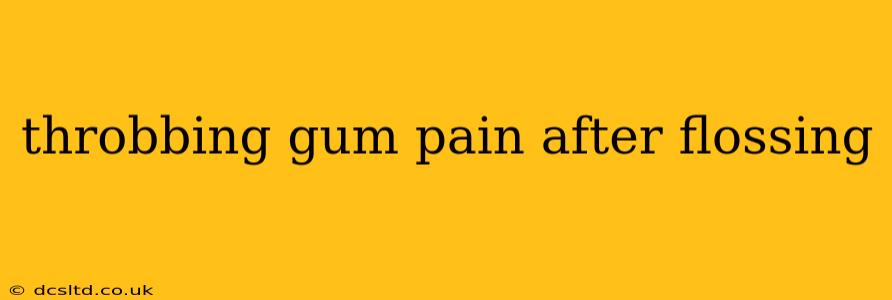Flossing is crucial for maintaining good oral hygiene, but sometimes, that fresh-feeling clean comes with an unwelcome side effect: throbbing gum pain. This isn't necessarily a sign that you're doing something wrong, but it's definitely a signal that something needs attention. Let's explore the potential causes of this pain and how to alleviate it.
Why Does My Gum Throb After Flossing?
The most common culprit is gum inflammation, often stemming from gingivitis (early gum disease). When you floss, you're dislodging plaque and bacteria that have accumulated along the gum line. This can temporarily irritate already inflamed gums, leading to throbbing pain. This pain is a sign your gums need more attention, not that flossing is harmful.
Is it Normal to Have Some Gum Discomfort After Flossing?
While some slight bleeding or tenderness is possible, especially if you haven't flossed regularly, throbbing pain is not normal. It indicates a more significant issue than just needing to floss more often. The throbbing sensation suggests inflammation and potentially infection.
What Can I Do to Relieve Throbbing Gum Pain After Flossing?
Several remedies can help alleviate the throbbing pain:
- Saltwater Rinse: Dissolve ½ to ¾ teaspoon of salt in 8 ounces of warm water. Swish this gently around your mouth for 30-60 seconds, then spit it out. Saltwater helps reduce inflammation and kill bacteria. Repeat this several times a day.
- Over-the-Counter Pain Relief: Ibuprofen or acetaminophen can help manage the pain. Always follow the dosage instructions on the packaging.
- Cold Compress: Apply a cold compress to the outside of your cheek over the affected area for 15-20 minutes at a time. This can help reduce swelling and numb the pain.
- Gentle Massage: Gently massage your gums with a clean finger to improve blood flow and reduce inflammation. Avoid applying excessive pressure.
How Can I Prevent Throbbing Gum Pain After Flossing?
Prevention is key! Here’s how to minimize the risk of throbbing gum pain after flossing:
- Proper Flossing Technique: Use a gentle sawing motion to guide the floss between your teeth, curving it around each tooth in a “C” shape. Avoid snapping the floss against your gums. There are many videos online demonstrating the correct technique.
- Regular Flossing: Consistent flossing is crucial. Aim to floss at least once a day to prevent plaque buildup.
- Regular Dental Checkups: Visit your dentist for regular checkups and cleanings. Professional cleanings remove plaque and tartar that you can't reach with flossing alone. Early detection and treatment of gum disease are essential.
- Balanced Diet: A healthy diet plays a significant role in oral health. Foods rich in vitamins and minerals contribute to stronger gums and overall well-being.
- Quit Smoking: Smoking significantly increases the risk of gum disease.
Could Throbbing Gum Pain After Flossing Indicate Gum Disease?
Yes, throbbing gum pain after flossing can be a sign of gum disease, particularly gingivitis or periodontitis. Gingivitis is characterized by inflamed gums that bleed easily, while periodontitis is a more advanced stage involving bone loss and potential tooth loss. If you experience persistent throbbing pain, bleeding gums, or receding gums, you should see a dentist immediately.
When Should I See a Dentist About Throbbing Gum Pain?
Don't hesitate to contact your dentist if:
- The pain is severe or persistent.
- You experience significant bleeding or swelling.
- Your gums are red, tender, or receding.
- You notice pus or other discharge.
Ignoring throbbing gum pain can lead to more serious dental problems. Early intervention is crucial for preventing and treating gum disease. Your dentist can properly diagnose the cause of your pain and recommend appropriate treatment. Don't delay seeking professional help if you're concerned.
